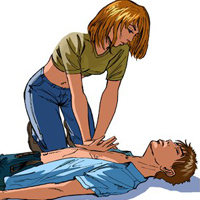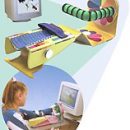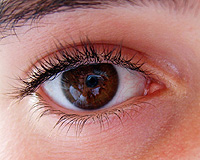Diagnostic search for comatose states is aimed at establishing the reasons that caused oppression consciousness. The right and timely adopted treatment tactics is of great importance, because it can significantly reduce the risk of developing complications.
Content
Diagnosis of coma
The patient who is unconscious is shown by treatment aimed at saving lives (for example, restoration of cardiac activity and respiration), even before determining the cause of this state. As soon as the condition of the patient, which is unconscious, stabilizes, the doctor determines the degree of reduction of the response to irritants and its causes.
In addition to medical tests (for example, a pulse frequency measurement and heart rate), a doctor, as a rule, prescribes complex laboratory studies that show the patient's brain. These studies may include CT (computed tomography), scanning and electroencephalography (EEG). Research and other organism functions are also held to determine any non-established disease in a patient or poisoning. For example, blood research, spinal fluid, liver and lungs can be conducted.
Emergency Assistance at Komach
Any person who is unconscious due to injury, illness or poisoning needs emergency medical care. If necessary, it is worth calling for assistance to the police. In any case, risky to transport the victim to the hospital without escort, at least one person, if there is no other exit. It is vital that a person who has lost consciousness is under constant observation in case of respiratory failure or blood circulation.
 It is necessary that a person who knows how to provide first aid or owning the recovery of cardiac activity and respiration, watched the state of the victim, who is unconscious, until the doctors are included in the work.
It is necessary that a person who knows how to provide first aid or owning the recovery of cardiac activity and respiration, watched the state of the victim, who is unconscious, until the doctors are included in the work.
The first thing you need to do is to provide the opportunity to breathe freely. If a person has lost consciousness due to injury to the head or spine, you can not move it and move your head, neck and back. This can only be done, provided that it is not possible to provide access to the lungs in any way. If there is confidence that it is not injured by the loss of consciousness, it is necessary to put the victims on the side and take the chin from the chest - this provision protects the loss of consciousness from the choke caused by hitting the distinguished saliva or the vomit in the respiratory tract, as it contributes to emptying the oral cavity. If necessary and possibly, it is recommended to conduct an indirect heart massage or artificial respiration.
A person who lost consciousness should be warm, but it should not be overheated. Even if he came to himself, it is impossible to give him either food or drinking nor medicine. Stomach, as far as possible, should be empty for some diagnostic and surgical measures. If the victim, who is unconscious, will begin vomiting, then he may choke a vomit mass and suffocate. If the state is such that with external damage, for example, during cuts, it can be rendered first aid, then it is necessary to carry out the processing of wounds.
Treatment of comatose state
 Many causes of comatose state, especially severe head injuries, can cause a cluster of fluid in the brain, which leads to an increase in intracranial pressure. Increased intracranial pressure may interfere with normal blood circulation and thereby entering the oxygen in the brain. If such an increased intracranial pressure is quickly not reduced, it can lead to gradual damage to the brain and then to death.
Many causes of comatose state, especially severe head injuries, can cause a cluster of fluid in the brain, which leads to an increase in intracranial pressure. Increased intracranial pressure may interfere with normal blood circulation and thereby entering the oxygen in the brain. If such an increased intracranial pressure is quickly not reduced, it can lead to gradual damage to the brain and then to death.
Since the physical activity of a person in comatose state ceases, symptoms associated with excessive muscle weakness may appear (this condition is characterized by weak muscle tone and muscle relaxation). Lack of movement can lead to the development of inflammation and infectious diseases of the skin, as well as to violation of metabolism. With proper treatment, all these complications can be warned.
Coma treatment involves the following events:
- Stabilization of breathing and blood circulation
- Reduced elevated intracranial pressure
- Treatment of the reason that caused someone
- Control over the functioning of the body using special equipment
Treatment may include the use of various drugs or surgical intervention (conducted in the case when other methods of treatment cannot reduce increased intracranial pressure or prevent its promotion). The main purpose of treatment is to prevent the death of the brain, in the case of which the human life is stopped both with medical and a legal point of view.
The purpose of treatment is also prevention of complications arising from a patient with a gradual strengthening of its reactions to external stimuli. This process may occupy months, and even years. As a rule, emergency hospitals do not have conditions and equipment for extensive and intensive treatment. However, numerous private clinics are equipped with everything necessary for the treatment of comatose patients, and some types of medical equipment are found only in them.
While a person is in a comatose state, blood circulation, breathing and other functions of its body must be under constant control. Ideally, the rehabilitation program should ensure the almost constant presence of irritants for the patients coming in. In one of the popular methods of treatment, first achieve restoration of the work of one senior authority in the patient. So, for example, in the case when the therapist focuses its efforts to restore hearing, it is daily for several hours in the patient's bed. With the help of this method, however, slowly, it seeks restoration of the patient a response to external stimuli, gradually enhancing them.
Even with intensive treatment in some patients in comatose state, improvement occurs very slowly or does not occur at all. Insecurity in the prosperous outcome of the disease can be extremely difficult for family, individual or collective discussion of the position of the patient can bring a family to some relief and give it support. Family members should understand that for patients who were in a coma and past rehabilitation treatment, the change in personality and behavior is completely ordinary, as well as various psychological problems. Adaptation of a person again to everyday life can occur with great difficulty even if the loss of consciousness was very short, and the patient completely came to himself.
Prevention of comatose states
Many head injuries leading to the development of coma can be warned by the simplest security measures, it is, first of all, the use of binding belts, car seats with head restraints or wearing a good protective helmet during sports or cycling and motorcycle ride. Diabetes patients should well know all factors capable of bringing them to a diabetic or hypoglycemic coma, and avoid them. Prevention measures of coma caused by other diseases are different for different diseases.









